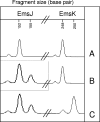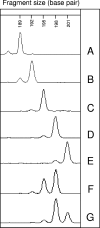Assessment of use of microsatellite polymorphism analysis for improving spatial distribution tracking of echinococcus multilocularis
- PMID: 17634311
- PMCID: PMC2045259
- DOI: 10.1128/JCM.02107-06
Assessment of use of microsatellite polymorphism analysis for improving spatial distribution tracking of echinococcus multilocularis
Abstract
Alveolar echinococcosis (AE)--caused by the cestode Echinococcus multilocularis--is a severe zoonotic disease found in temperate and arctic regions of the northern hemisphere. Even though the transmission patterns observed in different geographical areas are heterogeneous, the nuclear and mitochondrial targets usually used for the genotyping of E. multilocularis have shown only a marked genetic homogeneity in this species. We used microsatellite sequences, because of their high typing resolution, to explore the genetic diversity of E. multilocularis. Four microsatellite targets (EmsJ, EmsK, and EmsB, which were designed in our laboratory, and NAK1, selected from the literature) were tested on a panel of 76 E. multilocularis samples (larval and adult stages) obtained from Alaska, Canada, Europe, and Asia. Genetic diversity for each target was assessed by size polymorphism analysis. With the EmsJ and EmsK targets, two alleles were found for each locus, yielding two and three genotypes, respectively, discriminating European isolates from the other groups. With NAK1, five alleles were found, yielding seven genotypes, including those specific to Tibetan and Alaskan isolates. The EmsB target, a tandem repeated multilocus microsatellite, found 17 alleles showing a complex pattern. Hierarchical clustering analyses were performed with the EmsB findings, and 29 genotypes were identified. Due to its higher genetic polymorphism, EmsB exhibited a higher discriminatory power than the other targets. The complex EmsB pattern was able to discriminate isolates on a regional and sectoral level, while avoiding overdistinction. EmsB will be used to assess the putative emergence of E. multilocularis in Europe.
Figures




Similar articles
-
EmsB, a tandem repeated multi-loci microsatellite, new tool to investigate the genetic diversity of Echinococcus multilocularis.Infect Genet Evol. 2006 Sep;6(5):390-400. doi: 10.1016/j.meegid.2006.01.006. Epub 2006 Feb 28. Infect Genet Evol. 2006. PMID: 16504596
-
Multi-locus microsatellite analysis supports the hypothesis of an autochthonous focus of Echinococcus multilocularis in northern Italy.Int J Parasitol. 2009 Jun;39(7):837-42. doi: 10.1016/j.ijpara.2008.12.001. Epub 2008 Dec 30. Int J Parasitol. 2009. PMID: 19150351
-
Red foxes harbor two genetically distinct, spatially separated Echinococcus multilocularis clusters in Brandenburg, Germany.Parasit Vectors. 2021 Oct 14;14(1):535. doi: 10.1186/s13071-021-05038-0. Parasit Vectors. 2021. PMID: 34649615 Free PMC article.
-
Assessment of the global pattern of genetic diversity in Echinococcus multilocularis inferred by mitochondrial DNA sequences.Vet Parasitol. 2018 Oct 15;262:30-41. doi: 10.1016/j.vetpar.2018.09.013. Epub 2018 Sep 27. Vet Parasitol. 2018. PMID: 30389009 Review.
-
On the geographic genetic variants of the cestode Echinococcus multilocularis with reference to the original descriptions from Bowles et al. (1992) and Bowles and McManus (1993), and their use.Parasitol Int. 2020 Apr;75:102039. doi: 10.1016/j.parint.2019.102039. Epub 2019 Dec 13. Parasitol Int. 2020. PMID: 31843686 Review.
Cited by
-
Deep amplicon sequencing highlights low intra-host genetic variability of Echinococcus multilocularis and high prevalence of the European-type haplotypes in coyotes and red foxes in Alberta, Canada.PLoS Negl Trop Dis. 2021 May 26;15(5):e0009428. doi: 10.1371/journal.pntd.0009428. eCollection 2021 May. PLoS Negl Trop Dis. 2021. PMID: 34038403 Free PMC article.
-
Detection of Asian genetic components in autochthonous human Echinococcus multilocularis infections from endemic Warmia-Masuria (north-eastern Poland).One Health. 2023 Aug 25;17:100623. doi: 10.1016/j.onehlt.2023.100623. eCollection 2023 Dec. One Health. 2023. PMID: 38024287 Free PMC article.
-
Public health risks associated with food-borne parasites.EFSA J. 2018 Dec 4;16(12):e05495. doi: 10.2903/j.efsa.2018.5495. eCollection 2018 Dec. EFSA J. 2018. PMID: 32625781 Free PMC article.
-
Typing of Echinococcus multilocularis by Region-Specific Extraction and Next-Generation Sequencing of the mitogenome.Front Microbiol. 2025 Feb 28;16:1535628. doi: 10.3389/fmicb.2025.1535628. eCollection 2025. Front Microbiol. 2025. PMID: 40092033 Free PMC article.
-
Genetic diversity of Echinococcus multilocularis and Echinococcus granulosus sensu lato in Kyrgyzstan: The A2 haplotype of E. multilocularis is the predominant variant infecting humans.PLoS Negl Trop Dis. 2020 May 13;14(5):e0008242. doi: 10.1371/journal.pntd.0008242. eCollection 2020 May. PLoS Negl Trop Dis. 2020. PMID: 32401754 Free PMC article.
References
-
- Bardonnet, K., R. Piarroux, L. Dia, F. Schneegans, A. Beurdeley, V. Godot, and D. A. Vuitton. 2002. Combined eco-epidemiological and molecular biology approaches to assess Echinococcus granulosus transmission to humans in Mauritania: occurrence of the ‘camel’ strain and human cystic echinococcosis. Trans. R. Soc. Trop. Med. Hyg. 96:383-386. - PubMed
-
- Bart, J. M., K. Bardonnet, M. C. Elfegoun, H. Dumon, L. Dia, D. A. Vuitton, and R. Piarroux. 2004. Echinococcus granulosus strain typing in North Africa: comparison of eight nuclear and mitochondrial DNA fragments Parasitology 128:229-234. - PubMed
-
- Bart, J. M., I. Breyer, B. Gottstein, T. Romig, and R. Piarroux. 2003. Development of molecular tools to explore genetic diversity in Echinococcus multilocularis. Helminthologia 40:117-121.
-
- Bart, J. M., J. Knapp, B. Gottstein, F. El-Garch, P. Giraudoux, M. L. Glowatzki, H. Berthoud, S. Maillard, and R. Piarroux. 2006. EmsB, a tandem repeated multi-loci microsatellite, new tool to investigate the genetic diversity of Echinococcus multilocularis. Infect. Genet. Evol. 6:390-400. - PubMed
-
- Bowles, J., D. Blair, and D. P. McManus. 1992. Genetic variants within the genus Echinococcus identified by mitochondrial DNA sequencing. Mol. Biochem. Parasitol. 54:165-173. - PubMed
Publication types
MeSH terms
Grants and funding
LinkOut - more resources
Full Text Sources

